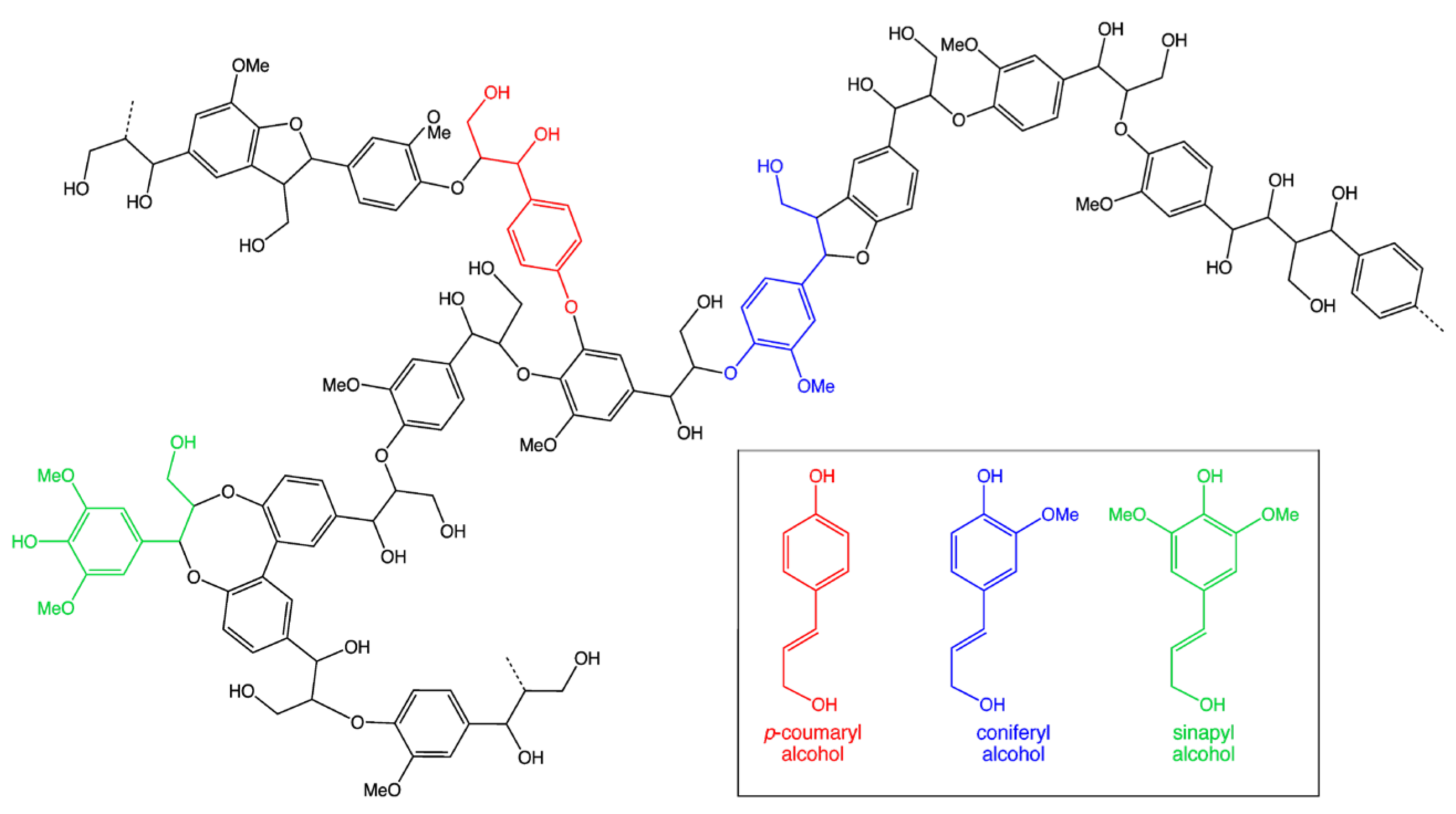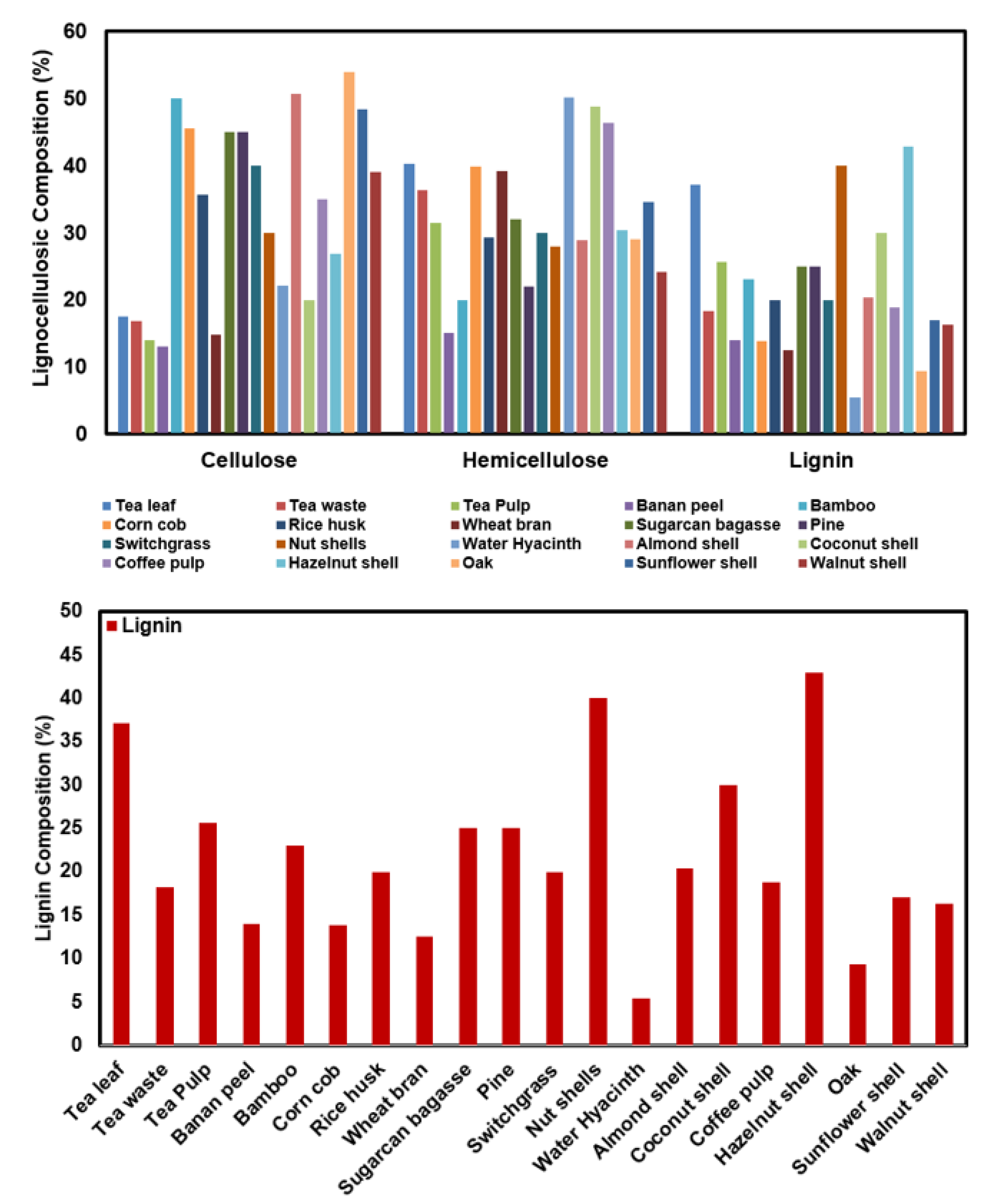Current Perspectives on the Applicability of Lignin Material in the Biosorption Process †
Abstract
1. Introduction
2. Material and Methods
3. Result and Discussion
3.1. Natural Lignin Chemical Properties
3.2. Classification of Lignin
- Sulfur containing: Kraft lignin (KL), lignosulfonates (LS);
- Sulfur free: Soda lignin (SL), organosolv lignin (OL), steam-explosion lignin (BL);
- Other types of lignin: Ground wood lignin (MWL), hydrolysis lignin (HL), pyrolysis lignin (PL);
- New generation (environmentally friendly): Ionic liquid lignin (IL), deep eutectic lignin (DÖÇL) [1].
3.3. Use of Biosorbent
4. Conclusions
Author Contributions
Funding
Institutional Review Board Statement
Informed Consent Statement
Data Availability Statement
Conflicts of Interest
References
- Gülsoy, S.K.; Pekgözlü Kılıç, A. Lignin. İn Classification and Molecule Weight; Serüven Publishing: Ankara, Türkiye, 2023; pp. 131–153. ISBN 978-625-6760-55-4. [Google Scholar]
- Wang, T.; Jiang, M.; Yu, X.; Niu, N.; Chen, L. Application of lignin adsorbent in wastewater treatment: A Review. Sep. Purif. Technol. 2022, 302, 122116. [Google Scholar] [CrossRef]
- Shao, L.; Liu, N.; Wang, Z.; Zhan, P.; Zhang, L.; Wu, Z. Functional Lignin-based Polymers: Isolation, Synthetic Methods and High-valued Applications. ChemistrySelect 2023, 8, e202301633. [Google Scholar] [CrossRef]
- Jha, A.; Kumar, A. Deciphering the Role of Sodium Lignosulfonate against Candida spp. as Persuasive Anticandidal Agent. Int. J. Biol. Macromol. 2018, 107, 1212–1219. [Google Scholar] [CrossRef] [PubMed]
- Fazeli, M.; Mukherjee, S.; Baniasadi, H.; Abidnejad, R.; Mujtaba, M.; Lipponen, J.; Seppala, J.; Rojas, J. Lignin beyond the status quo: Recent and emerging composite applications. Green Chem. 2024, 26, 593–630. [Google Scholar] [CrossRef] [PubMed]
- Gosselink, R.J.A.; De Jong, E.; Guran, B.; Abächerli, A. Co-Ordination Network for Lignin—Standardisation, Production andApplications Adapted to Market Requirements (EUROLIGNIN). Ind. Crops Prod. 2004, 20, 121–129. [Google Scholar] [CrossRef]
- Berlin, A.; Balakshin, M. Industrial Lignins. In Bioenergy Research: Advances and Applications; Elsevier: Amsterdam, The Netherlands, 2014; pp. 315–336. ISBN 978-0-444-59561-4. [Google Scholar]
- Lora, J. Industrial Commercial Lignins: Sources, Properties and Applications. In Monomers, Polymers and Composites from Renewable Resources; Elsevier: Amsterdam, The Netherlands, 2008; pp. 225–241. ISBN 978-0-08-045316-3. [Google Scholar]
- Dong, X.; Dong, M.; Lu, Y.; Turley, A.; Jin, T.; Wu, C. Antimicrobial and Antioxidant Activities of Lignin from Residue of Corn Stover to Ethanol Production. Ind. Crops Prod. 2011, 34, 1629–1634. [Google Scholar] [CrossRef]
- Reyes, D.C.; Ma, Z.; Romero, J.J. The Antimicrobial Properties of Technical Lignins and Their Derivatives—A Review. Polymers 2024, 16, 2181. [Google Scholar] [CrossRef]
- Cheng, X.; Plma, B.; Zhao, H.; Zhang, H.; Wang, J.; Chen, Z.; Hu, J. Photoreforming for Lignin Upgrading: A Critical Review. ChemSusChem 2023, 16, e202300675. [Google Scholar] [CrossRef] [PubMed]
- Ruthran, V.B.; Barmaan, P.; Kada, R.; Kumar, A. Lignin-based adsorbent for effective removal of toxic heavy metals from wastewater. Emergent Mater. 2022, 5, 923–943. [Google Scholar]
- Torres, L.A.Z.; Woiciechowski, A.L.; de Andrade Tanobe, V.O.; Karp, S.G.; Lorenci, L.C.G.; Faulds, C.; Soccol, C.R. Lignin as a potential source of high-added value compounds: A review. J. Clean. Product. 2020, 263, 121499. [Google Scholar] [CrossRef]
- Xu, C.; Ferdosian, F. Conversion of Lignin into Bio-Based Chemicals and Materials. In Green Chemistry and Sustainable Technology; Springer: Berlin/Heidelberg, Germany, 2017; ISBN 978-3-662-54959-9. [Google Scholar]
- Gonçalves, S.; Ferra, J.; Paiva, N.; Martins, J.; Carvalho, L.H.; Magalhães, F.D. Lignosulphonates as an Alternative to Non-Renewable Binders in Wood-Based Materials. Polymers 2021, 13, 4196. [Google Scholar] [CrossRef] [PubMed]
- Suzuki, M.; Kondor, A.; Sakuraba, Y.; Rojas, O.J.; Ago, M. Surface energy properties of lignin particles studied by inverse gas chromatography and interfacial adhesion in polyester composites with electromagnetic transparency. Cellulose 2022, 29, 2961–2973. [Google Scholar] [CrossRef]
- Kainth, S.; Sharma, P.; Pandey, O.P. Green sorbents from agricultural wastes: A review of sustainable adsorption materials. Appl. Surf. Sci. Adv. 2024, 19, 100562. [Google Scholar] [CrossRef]
- Supanchaiyamat, N.; Jetsrisuparb, K.; Knijnenburg, J.T.N.; Tsang, D.C.W.; Hunt, A.J. Lignin materials for adsorption: Current trend, perspectives and opportunities. Bioresour. Technol. 2019, 272, 570–581. [Google Scholar] [CrossRef] [PubMed]
- Zhang, H.; Xue, K.; Wang, B.; Ren, W.; Sun, D.; Shao, C.; Sun, R. Advances in lignin-based biosorbents for sustainable wastewater treatment. Bioresour. Technol. 2024, 395, 130347. [Google Scholar] [CrossRef] [PubMed]
- Zhang, Z.; Chen, Y.; Wang, D.; Yu, D.; Wu, C. Lignin-based adsorbents for heavy metals. Ind. Crops Prod. 2023, 193, 116119. [Google Scholar] [CrossRef]
- Santander, P.; Butter, B.; Oyarce, E.; Yanez, M.; Xiao, L.P.; Sanchez, J. Lignin-based adsorbent materials for metal ion removal from wastewater: A review. Ind. Crops Prod. 2021, 167, 113510. [Google Scholar] [CrossRef]
- Maia, L.C.; Soares, L.C.; Gurgel, L.V.A. A review on the use of lignocellulosic materials for arsenic adsorption. J. Environ. Manage. 2021, 288, 112397. [Google Scholar] [CrossRef] [PubMed]
- Yuan, Y.; Jiang, B.; Chen, H.; Wu, W.; Wu, S.; Jin, Y.; Xiao, H. Recent advances in understanding the efects of lignin structural characteristics on enzymatic hydrolysis. Biotechnol. Biofuels 2021, 14, 205. [Google Scholar] [CrossRef] [PubMed]
- Okolie, J.A.; Nanda, S.; Dalai, A.K.; Kozinski, J.A. Chemistry and specialty industrial applications of lignocellulosic biomass. Waste Biomass Valori. 2021, 12, 2145–2169. [Google Scholar] [CrossRef]


| Characteristics Peaks | Functional Group |
|---|---|
| 3363 cm−1 | OH |
| 2935–2863 cm−1 | C-H stretching |
| 1597 cm−1 | Aromatic functionality |
| 1512 cm−1 | Aromatic skeletal vibration |
| 1460–1425 cm−1 | C-H deformation |
| 1327 cm−1 | C-O stretching in syringyl |
| 1214 cm−1 | C-O-C soft segment |
| 1115–1032 cm−1 | C-H stretching of polysaccharides |
| 824–619 cm−1 | Other C-H peaks |
Disclaimer/Publisher’s Note: The statements, opinions and data contained in all publications are solely those of the individual author(s) and contributor(s) and not of MDPI and/or the editor(s). MDPI and/or the editor(s) disclaim responsibility for any injury to people or property resulting from any ideas, methods, instructions or products referred to in the content. |
© 2025 by the authors. Licensee MDPI, Basel, Switzerland. This article is an open access article distributed under the terms and conditions of the Creative Commons Attribution (CC BY) license (https://creativecommons.org/licenses/by/4.0/).
Share and Cite
Çelebi, H.; Bahadir, T.; Şimşek, İ.; Tulun, Ş. Current Perspectives on the Applicability of Lignin Material in the Biosorption Process. Eng. Proc. 2024, 81, 17. https://doi.org/10.3390/engproc2024081017
Çelebi H, Bahadir T, Şimşek İ, Tulun Ş. Current Perspectives on the Applicability of Lignin Material in the Biosorption Process. Engineering Proceedings. 2024; 81(1):17. https://doi.org/10.3390/engproc2024081017
Chicago/Turabian StyleÇelebi, Hakan, Tolga Bahadir, İsmail Şimşek, and Şevket Tulun. 2024. "Current Perspectives on the Applicability of Lignin Material in the Biosorption Process" Engineering Proceedings 81, no. 1: 17. https://doi.org/10.3390/engproc2024081017
APA StyleÇelebi, H., Bahadir, T., Şimşek, İ., & Tulun, Ş. (2024). Current Perspectives on the Applicability of Lignin Material in the Biosorption Process. Engineering Proceedings, 81(1), 17. https://doi.org/10.3390/engproc2024081017






